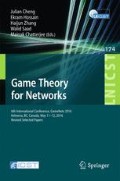Abstract
We present a network influence game that models players strategically seeding the opinions of nodes embedded in a social network. A social learning dynamic, whereby nodes repeatedly update their opinions to resemble those of their neighbors, spreads the seeded opinions through the network. After a fixed period of time, the dynamic halts and each player’s utility is determined by the relative strength of the opinions held by each node in the network vis-à-vis the other players. We show that the existence of a pure Nash equilibrium cannot be guaranteed in general. However, if the dynamics are allowed to progress for a sufficient amount of time so that a consensus among all of the nodes is obtained, then the existence of a pure Nash equilibrium can be guaranteed. The computational complexity of finding a pure strategy best response is shown to be \(\mathrm {NP}\)-complete, but can be efficiently approximated to within a \((1 - 1/e)\) factor of optimal by a simple greedy algorithm.
This research was conducted while S.D. Johnson was a graduate student at the University of California, Davis.
Access this chapter
Tax calculation will be finalised at checkout
Purchases are for personal use only
Notes
- 1.
- 2.
We use \(\varGamma ^T\) to denote the matrix \(\varGamma \) raised to the Tth power. For matrix transposition, we use the notation \(\varGamma ^\intercal \).
- 3.
A set function \(f : \varOmega \rightarrow \mathbb {R}\) is submodular if, for every \(X \subseteq Y \subset \varOmega \) and element \(x \in \varOmega \setminus Y\), we have \(f(X \cup \{x\}) - f(X) \ge f(Y \cup \{x\}) - f(Y)\).
References
Alon, N., Feldman, M., Procaccia, A.D., Tennenholtz, M.: A note on competitive diffusion through social networks. Inf. Process. Lett. 110(6), 221–225 (2010)
Banerjee, A., Chandrasekhar, A.G., Duflo, E., Jackson, M.O.: The diffusion of microfinance. Science 341(6144), 363–371 (2013)
Banerjee, A.V., Chandrasekhar, A., Duflo, E., Jackson, M.O.: Gossip: Identifying central individuals in a social network. Working Paper, August 2014
Bharathi, S., Kempe, D., Salek, M.: Competitive influence maximization in social networks. In: Deng, X., Graham, F.C. (eds.) WINE 2007. LNCS, vol. 4858, pp. 306–311. Springer, Heidelberg (2007). doi:10.1007/978-3-540-77105-0_31
Borodin, A., Filmus, Y., Oren, J.: Threshold models for competitive influence in social networks. In: Saberi, A. (ed.) WINE 2010. LNCS, vol. 6484, pp. 539–550. Springer, Heidelberg (2010). doi:10.1007/978-3-642-17572-5_48
DeGroot, M.H.: Reaching a consensus. J. Am. Stat. Assoc. 69(345), 118–121 (1974)
DeMarzo, P.M., Vayanos, D., Zweibel, J.: Persuasion bias, social influence, and unidimensional opinions. Q. J. Econ. 118(3), 909–968 (2003)
Fotakis, D., Lykouris, T., Markakis, E., Obraztsova, S.: Influence maximization in switching-selection threshold models. In: Lavi, R. (ed.) SAGT 2014. LNCS, vol. 8768, pp. 122–133. Springer, Heidelberg (2014). doi:10.1007/978-3-662-44803-8_11
Golub, B., Jackson, M.O.: How homophily affects the speed of contagion, best response and learning dynamics. Working Paper, September 2010
Golub, B., Jackson, M.O.: Naïve learning in social networks and the wisdom of crowds. Am. Econ. J. Microeconomics 2(1), 112–149 (2010)
Goyal, S., Heidari, H., Kearns, M.: Competitive contagion in networks. Games and Economic Behavior (2014) (in press)
Jackson, M.O.: Social and Economic Networks. Princeton University Press, Princeton (2008)
Jackson, M.O.: An overview of social networks and economic applications. In: Benhabib, J., Bisin, A., Jackson, M.O. (eds.) Handbook of Social Economics, chap. 12, pp. 511–585. North Holland, San Diego (2011)
Kempe, D., Kleinberg, J., Tardos, É.: Maximizing the spread of influence through a social network. In: Proceedings of the Ninth ACM SIGKDD International Conference on Knowledge Discovery and Data Mining, KDD 2003, pp. 137–146. ACM, New York (2003)
Mossel, E., Roch, S.: Submodularity of influence in social networks: from local to global. SIAM J. Comput. 39(6), 2176–2188 (2010)
Nemhauser, G.L., Wolsey, L.A., Fisher, M.L.: An analysis of approximations for maximizing submodular set functions—i. Math. Program. 14(1), 265–294 (1978)
Tzoumas, V., Amanatidis, C., Markakis, E.: A game-theoretic analysis of a competitive diffusion process over social networks. In: Goldberg, P.W. (ed.) WINE 2012. LNCS, vol. 7695, pp. 1–14. Springer, Heidelberg (2012). doi:10.1007/978-3-642-35311-6_1
Acknowledgements
The authors gratefully acknowledge support from the US Army Research Office MURI Award No. W911NF-13-1-0340 and Cooperative Agreement No. W911NF-09-2-0053.
Author information
Authors and Affiliations
Corresponding author
Editor information
Editors and Affiliations
Rights and permissions
Copyright information
© 2017 ICST Institute for Computer Sciences, Social Informatics and Telecommunications Engineering
About this paper
Cite this paper
Johnson, S.D., George, J., D’Souza, R.M. (2017). Strategic Seeding of Rival Opinions. In: Cheng, J., Hossain, E., Zhang, H., Saad, W., Chatterjee, M. (eds) Game Theory for Networks. GameNets 2016. Lecture Notes of the Institute for Computer Sciences, Social Informatics and Telecommunications Engineering, vol 174. Springer, Cham. https://doi.org/10.1007/978-3-319-47509-7_1
Download citation
DOI: https://doi.org/10.1007/978-3-319-47509-7_1
Published:
Publisher Name: Springer, Cham
Print ISBN: 978-3-319-47508-0
Online ISBN: 978-3-319-47509-7
eBook Packages: Computer ScienceComputer Science (R0)

